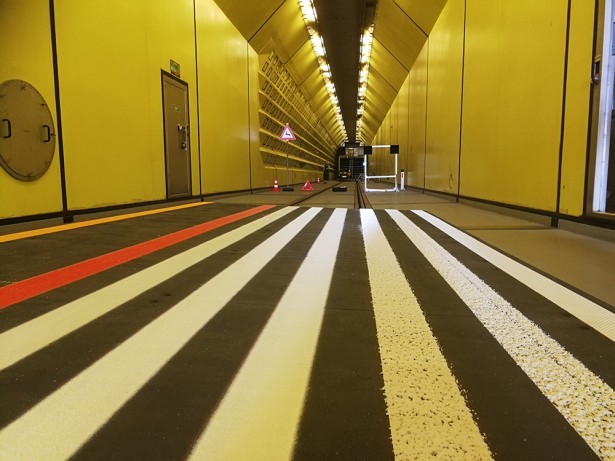Swarco focuses on machine-readable road markings
First published in Intertraffic Innovation News - May 26, 2020
 Recognition of Swarco road markings by lidar and camera tested in the world‘s biggest climate and wind tunnel in cooperation with ZKW
Recognition of Swarco road markings by lidar and camera tested in the world‘s biggest climate and wind tunnel in cooperation with ZKWConsider for a moment: autonomous vehicles, or indeed cars with driver assistance systems, such as autopilot, depend on road markings to properly position themselves on the road. In preparing for connected and autonomous vehicles (CAV), authorities in Europe and America, and indeed other regions of the world, are recommending stricter standards for the quality of road markings. These include proper design to new standards, good maintenance, and reliable recognition for the human eye and the optical and machine vision systems of vehicles with advanced driver assistance capabilities.
Leading road marking expert Swarco already provides sustainable systems that meet and exceed the strictest demands for both human and machine vision. High retroreflectivity (RL), reaching as much as 1000 mcd/m²/lx in white paint and exceeding 100 mcd/m²/lx under wet conditions, can be readily achieved through drop-on Swarco Solidplus or Swarco Duralux premium glass beads, as demonstrated in test applications in Switzerland (structured cold plastic), in Poland (waterborne paint), and in the United States (yellow thermoplastic dots).
However, Swarco wanted to dive deeper into machine readability and worked with Austrian automotive lighting specialist ZKW Group to carry out tests in the world’s largest climate and wind tunnel in Vienna. Several classes of road marking solutions (paint, tape, structured cold plastic), differing also in RL, were tested for their suitability to be read by machine vision equipment under various conditions: daylight and darkness, dry, mist, rain, heavy rain, and fog, as well as with interfering light (glare effects) and in windy environments. It was found that camera and lidar complemented each other perfectly and their combination was sufficient to correctly recognise all road markings with appropriately high RL. Whereas for a camera, glare and low contrast ratio very significantly lowered marking recognition during daytime, these factors hardly hindered recognition by lidar.
In darkness and under limited visibility conditions, retro-reflectivity played the major role for both camera and lidar. Of course, human drivers also benefit significantly from these new, higher standards of road marking, and they can ultimately help to increase road safety.
Companies in this article
Swarco











